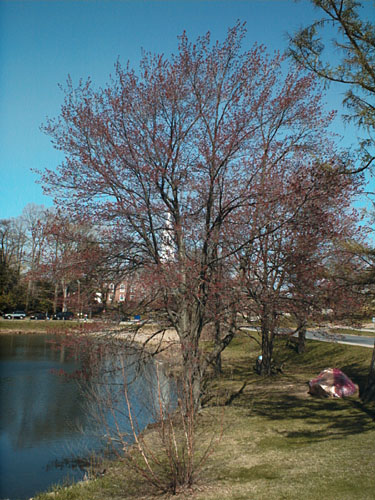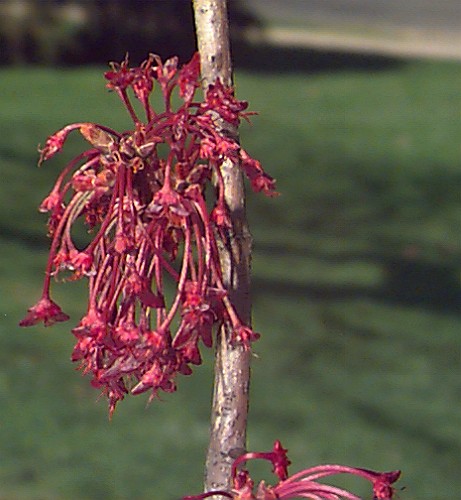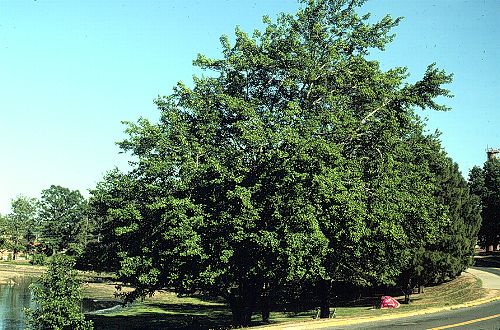Acer rubrum
Red Maple, Swamp Maple
Aceraceae
ExpandHabitat
- very large geographic and climatic range
- eastern United States and adjacent Canada
- zone 3, but plants must have originated from the northern part of its range
Habit and Form
- deciduous
- pyramidal or elliptical when young
- becomes more spreading with age, eventually developing a more or less rounded or oval outline
- a medium to large tree, 40' to 70' tall, but can be over 100' tall
- texture is medium
- relatively fast growing
Summer Foliage
- opposite, 2" to 4" long, 3 or 5-lobed
- medium green upper leaf color, gray-green or frosty underside
Autumn Foliage
- varies from greenish yellow to vibrant scarlet to burgundy
- can be very striking; many cultivars selected for red fall foliage
- often one of the first trees to color
Flowers
- red or orange, in late March and April, showy
- monoecious with male and female flowers on separate branches of a tree; some flowers may be perfect as well
- female flowers more showy with redder color
Fruit
- samaras, 0.75" long
- often display some red color and ornamental appeal
Bark
- attractive and a useful ornamental feature
- young bark is smooth and light, ash-gray, almost silver
- older branches and trunk are covered with scaly gray brown bark
- bark contrasts well with early spring flowers
Culture
- easy to transplant and establish
- tolerant of many conditions and adaptable
- prefers moist, acidic soils
- tolerates occasional flooding and wet soils
- on alkaline soils develops manganese chlorosis
- full sun best for landscape development, but can tolerate partial shade
Landscape Uses
- for shade in lawns, parks, campuses
- good for fall foliage color and bark
- good street tree
Liabilities
- can be somewhat weak wooded and may suffer storm damage
- because the species is so genetically diverse careful attention is needed to insure adequate cold hardiness and the desired red fall foliage
- manganese chlorosis
- tar spot, verticillium wilt leaf hoppers
ID Features
- ashy-gray bark
- clusters of "Christmas ornament" flower buds along with smaller vegetative buds
- twigs produce an odor when broken
- confused with Acer saccharinum. In leaf, leaf shapes separate species. Out of leaf A. rubrum doesn't have "droop and swoop" branch tips like A. saccharinum
- old bark not as shaggy or silvery as A. saccharinum
Propagation
- by seed
- no longer grafted due to incompatibilities
- cultivars are by stem cuttings or tissue culture
Cultivars/Varieties
'Armstrong'- An upright or fastigiate selection that grows to around 60' tall and 15' wide. Lacks consistent orange or red fall color. May be an A. rubrum x A. saccharinum hybrid (Acer x freemanii).
'Autumn Flame' - Notable for its pleasant rounded habit as a young tree, growing to 60' tall. Good fall color and smaller leaves than normal. May lack the hardiness of other cultivars.
'Bowhall' - An upright, pyramidal form that is significantly wider than 'Armstrong' or 'Columnare'. Fall color is yellow-orange with red highlights.
'Columnare' - Similar to 'Armstrong', but slower growing and more compact. Has better summer foliage quality and dependable orange-red fall color.
'Franksred' (Red Sunset®) - Pyramidal to rounded form. Striking red fall color. Earlier color development than 'October Glory' and more cold hardy. Grows to 45 to 50' tall.
'Northwood' (Northwood®) - A cultivar selected for its fine tolerance of harsh winter conditions. The crown is oval and the branches ascend upwards. Fall color may not be as effective as other selections, and some have suggested that the growth form may become irregular with age.
'October Glory' (October Glory®) - Develops good red to burgundy fall color and has dark green summer foliage. Colors late in October. May have limitations as far as cold hardiness and winter twig kill susceptibility. Oval shape, 40' to 50' tall.


































